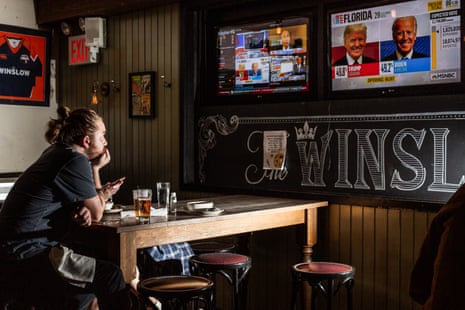After months of nerve-jangling campaigning that at times appeared to be tearing the world’s oldest constitutional democracy apart, the US presidential election finally reached its climax and entered the comfortingly familiar bubble of TV news election night.
But there was nothing familiar about this election, not in pandemic 2020.
From the start of the night, presenters from CNN to Fox News had two words ringing in their ears as they tried to hold on tight to a long and nail-biting night: patience and caution.
Patience because of the vast pile of more than 100m early votes cast and caution because of the unprecedented stakes of the race. “The level of anxiety! The level of emotional fatigue!” said CNN’s Van Jones, expressing the heartfelt yearning of millions of Americans. “If you are a Muslim family, if you are from an immigration community, if you are vulnerable in any way, this has been an horrific four years, so people would vote for Kermit the Frog over Donald Trump at this point.”
Fox News recognised the exceptionally twisty nature of the night. “The results as they come in are going to be a little bewildering because we will be looking at a peculiar blend of votes that have and have not been counted,” said the channel’s senior political analyst Brit Hume. “We should prepare our audience to bear with us, because it’s getting very complex.”
At least Wolf Blitzer, the CNN anchor whose prime skill is making drying paint sound breathlessly like world-shattering news, kept in character, throwing all caveats to the winds. “It’s a bit of a surprise,” he screeched when results started coming in from Kentucky showing Joe Biden ahead.
Blitzer had to be gently nudged by a colleague, who pointed out that only 8% of votes were in at that time. Kentucky was soon after called for Trump, which was not a bit of a surprise – the state has clung to the Republican in every race since 1996.
Huge turnout

Even before election night began, the country had witnessed nationwide scenes of determined voting at astonishing levels. The sleeping giant of the US electorate – traditionally among the most laggardly at voting among the developed countries – had suddenly stirred.
From the critical swing state of Florida, through the rust belt states that in no small part delivered Trump his victory four years ago, amid a snow squall in New Hampshire, and right across to the vast Democratic stronghold of California, Americans turned out to vote in record numbers. The rate at which they did so was set to surpass all presidential elections since 1908.
After all the fears of armed intimidation at the polls, of militia groups descending on polling stations to wreak havoc, election day was overwhelmingly orderly and calm. Sporadic local squabbles over voting machine breakdowns and scurrilous spam calls were recorded, as they regularly are in US presidential races.
State after state broke voting records. Texas, which last voted for a Democratic presidential candidate in 1976, received more early votes than the entirety of the poll in 2016. Florida recorded 9m early votes, some 63% of the total – another jaw-dropping showing.
It may come to be seen as one of the great paradoxes of the 2020 cycle that an election that brought American democracy to the brink of collapse triggered an outbreak of democratic participation unlike any in modern times.
It was in Florida that the first true drama of the night erupted. The state, with its track record of razor-close presidential elections, was a must-win state for Trump. As the results poured in from 7pm, the president’s numbers appeared to be promising.

In particular, Trump’s fearmongering message that Biden was going to destroy the country by dragging it into socialism received a predictably warm response from Cuban Americans in Miami-Dade county. Elsewhere in the state, Biden was doing well in suburban areas around Tampa in central Florida and Jacksonville in the north, but his prospects of grabbing back Florida looked slim. By 12.35am ET, the Associated Press had called the state for Trump.
For the millions of Democratic Americans for whom election night 2016 continues to cause night sweats in a bad case of PTSD, Trump’s performance in Florida was like being forced to live it all again. By around 10.30pm local time, the sinking feeling that the country might be repeating the shock of four years ago had begun to spread jitter and alarm among the nation’s liberals and progressives, even though they knew that the mass of mailed votes could complicate the story.
Just as Fox News said, this was going to “get very complex”. While Democrats were fretting over Florida, Virginia quietly and almost unnoticed was called by Associated Press for Biden. When Barack Obama won Virginia in 2008, it was considered a Republican state that was shifting leftwards. The last time it had backed a Democrat was in 1964 with Lyndon Johnson.
Now, as the rapid declaration for Biden showed, the state is firmly in the Democratic column, a product of shifting demographics, an increasingly diverse electorate and the expansion of the more progressive suburbs. The same pattern is echoed in several of the other states that Biden was chasing on election night – North Carolina, Ohio and Arizona to name but three.
Even Texas, a state that has backed the Republican in every presidential race since Jimmy Carter, began the night with the recorded votes going for Biden. That lead did not survive the night, but it indicated the turbulent churn of the electoral pot as the night set in.
Annika Tierney was one of those Democratic voters vying for seismic change in Texas. She grabbed the chance to vote in the state capital, Austin, with just half an hour to spare.
Given the spectres of “Trumpers”, voter intimidation and Covid-19, she wasn’t sure if she was going to vote at all. One anxiety attack behind her, she decided to risk even the possibility of catching a deadly virus to make her voice heard.
Tierney, 29, saw the election as “a way out” and an opportunity to “not feel so lost”. “I just hope that there is a complete, sweeping change of everything,” she said.
The long night

As Tuesday slipped into Wednesday, the realisation that the result of the 2020 presidential race could take hours, even days, to be known set in. The decision desk of Fox News called Arizona for Biden, prompting a furious response from the Trump campaign, which complained the call was far too soon.
As other channels and the Associated Press continued to bide their time on Arizona, all eyes once again began to turn inexorably to the rustbelt three – the so-called “blue wall” of Pennsylvania, Michigan and Wisconsin which Clinton had depended on and which Trump tore down in 2016. Both Trump and Biden devoted much of their final energies in the race on a tug-of-war over these firewall states.
All three states could take days to reach a final outcome. In Wisconsin, vote-rich Milwaukee was expected to release its results well into Wednesday morning.
Michigan’s election authorities indicated it may take until Friday to count the huge number of mail-in votes. In Pennsylvania, which again appears to be pivotal as it was in 2016, ballots that were postmarked by election day can arrive as late as Friday and still be eligible to be counted following a recent US supreme court decision.
Shortly before 1am on Wednesday, Biden delivered his anticipated speech from his home town of Wilmington, Delaware. He spoke from a makeshift stage in front of the Chase Center where he had formally accepted his nomination in August.
Biden urged patience and insisted that he remained confident. “We knew this was going to take time. But we feel good, we really do. We believe we’re on track to win this election. We knew because of the unprecedented early vote it would take a while so we have to be patient.”
Trump had rounded off his election day with a visit to his campaign headquarters in Virginia, where even this most dogmatic of candidates revealed a sliver of doubt. “Winning is easy. Losing is never easy, not for me it’s not,” Trump said in a visit to his campaign headquarters earlier in the day.
From there it was on to an election night party in the White House attended by several hundred guests behind a newly installed “non-scalable” perimeter fence. Whether his unconventional choice of venue will culminate in another White House “super-spreader” event like the recent gathering in the Rose Garden marking the confirmation of Amy Coney Barrett for the US supreme court will be a question for coming days.
In remarks at 2am, Trump made baseless accusations about “fraud” in the election and falsely declared victory without results to back up his claims. In his eagerness to sow doubt over the election’s legitimacy and call himself the winner, he said victory should be declared in Georgia and North Carolina, where the counts were still under way. But he simultaneously urged more counting in Arizona, where he was behind.
About 20 minutes after his speech ended, the AP called the race for Biden in Arizona.
Amid all the swirl and the uncertainty, the anxious and despairing voices of voters on this tumultuous day echoed through the night. “There’s a mass divide that just seems to keep growing,” said Christopher Henson, a voter in Ravenna, Ohio. “There’s a lot of civil unrest and it’s probably going to get worse, regardless of how the election turns out.”
Marcos Antonio Valero, who voted for Trump in Miami, said he was at a loss to say what would come of it all. “It’s a secret, a mystery,” he said. “No one knows how it’s going to end – until we all know.”
